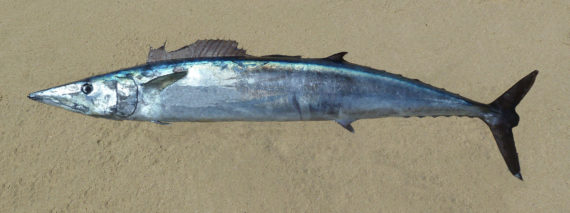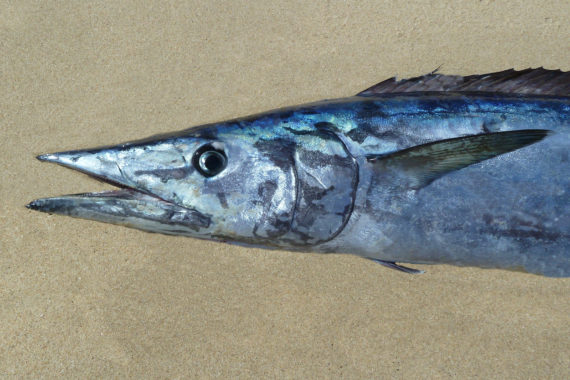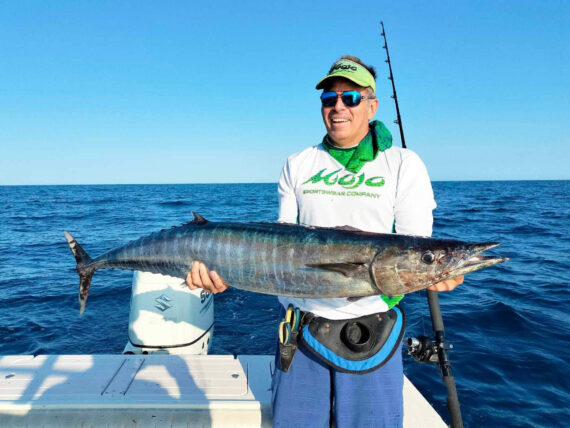Wahoo, Acanthocybium solandri

 Wahoo, Acanthocybium solandri. Fish caught from coastal waters off Point Palmilla, Baja California Sur, March 2015. Length: 1.17 meters (3 feet 10 inches).
Wahoo, Acanthocybium solandri. Fish caught from coastal waters off Point Palmilla, Baja California Sur, March 2015. Length: 1.17 meters (3 feet 10 inches).
 Wahoo, Acanthocybium solandri. Fish caught from coastal waters off Loreto, Baja California Sur, November 2023. Length: 1.27 m (4 feet 2 inches). Weight: 16 kg (34 lbs). Catch, photograph, and identification courtesy of Chris Wheaton, Fullerton, California.
Wahoo, Acanthocybium solandri. Fish caught from coastal waters off Loreto, Baja California Sur, November 2023. Length: 1.27 m (4 feet 2 inches). Weight: 16 kg (34 lbs). Catch, photograph, and identification courtesy of Chris Wheaton, Fullerton, California.
 Wahoo, Acanthocybium solandri. Fish caught from coastal waters off Loreto, Baja California Sur, April 2016. Length: 1.75 m (5 feet 9 inches). Weight: 38 kg (84 lbs). Catch, photograph, and identification courtesy of Chris Wheaton, Fullerton, California.
Wahoo, Acanthocybium solandri. Fish caught from coastal waters off Loreto, Baja California Sur, April 2016. Length: 1.75 m (5 feet 9 inches). Weight: 38 kg (84 lbs). Catch, photograph, and identification courtesy of Chris Wheaton, Fullerton, California.
The Wahoo, Acanthocybium solandri, is a member of the Mackerel or Scombridae Family, and is known in Mexico as peto or WAHOOOO! This fish is the only species in the genus Acanthocybium and one of the few species found in Mexican waters of both the Atlantic and the Pacific Ocean.
The Wahoo has an elongated slightly compressed fusiform body that is designed aerodynamically for speed. They are iridescent blue-green dorsally and transition to silver ventrally with 24 to 30 irregular striking vertical cobalt blue bars on their sides, some of which are double “Y” shaped. They have a large mouth with a long pointed beak-like snout and strongly compressed triangular finely serrated sharp teeth. Their anal fin has 12 to 14 rays followed by 9 finlets; their caudal fin is deeply forked with 2 small keels separated by 1 large keel at the base; their first dorsal fin has long base with 23 to 27 spines; their second dorsal fin has 12 to 16 rays followed by 8 or 9 finlets; and, their pelvic fins are inserted below the pectoral fins. They have do not have gill rakers. Their body is covered with small scales. Their lateral line is complete and curves abruptly under the first dorsal fin.
The Wahoo is a global pelagic species found worldwide in tropical and subtropical waters. They are mainly found offshore from the surface to depths up to 295 m (970 feet) but will approach the shore in pursuit of small baitfish when food is abundant. They reach a maximum of 2.5 m (8 feet 2 inches) in length and 83.5 kg (184 lbs) in weight. As of January 1, 2024, the International Game Fish Association world record stood at 83.5 kg (184 lbs) with the fish caught in coastal waters off Cabo San Lucas, Baja California Sur, in July 2005. They are a highly migratory species and move to cooler waters during the summer months. They travel as solitary individuals or in small schools of up to 100 individuals. They are known to collect in and around drifting objects such as driftwood and patches of seagrass. This website includes a Weight From Length Conversion Table for the Wahoo allowing one to estimate with good accuracy the weight of a fish from its fork length. This allows the pleasure of catching a fish, determining its weight, and returning it to the ocean unharmed to live another day. The Wahoo is one of the fastest fish in the ocean capable of quickly accelerating to speeds of 100 km per hour (60 mph). They are opportunistic predators that feed primarily on other pelagic fish including tuna, flyingfish, dorados, jacks, herrings, pilchards, scads, and lanternfish as well as squid. They are preyed upon by various sharks, specifically the Silvertip Shark, Carcharhinus albimarginatus, and other large predatory fish. They have the ability to escape many predators due to their swimming speeds and strong endurance. They are relatively abundant, fast growing, and very fecund. Reproduction is oviparous with very short reproduction times. Females reach their reproductive age in 1 year and males in 2 years. Females are multiple batch spawners and highly fecund; they are known to spawn every 2 to 6 days or a total of 20 to 26 times a year releasing up to 100,000,000 eggs per year. Fertilization is external and the eggs and larvae are pelagic. Juveniles grow quickly and can triple their length in one year and then grow at about 4.0 cm (1.5 inches) per month thereafter. They are fast growing but have a high mortality rate. They have lifespans of up to nine years.
The Wahoo is a resident of all Mexican waters of the Atlantic and the Pacific Oceans. In the Pacific they are absent from north of Loreto, Baja California Sur, within the Sea of Cortez.
The Wahoo is a straightforward identification that cannot be confused with any other species.
From a conservation perspective the Wahoo is currently considered to be Least Concern with stable, widely distributed populations. They are not currently fished commercially, most likely because they are not a schooling species and therefore difficult to catch in abundance. They are caught primarily by longliners as a by-catch of other commercial fisheries targeting billfish, dorado, and tuna and have been taken at increasing rates, although catch levels are poorly documented. They have a wide global distribution with annual catch levels estimated at 8,000 tons. There are a limited number of global controls in place to help with conservation of this species. They are considered a quality food fish but also known to contain ciguatoxin and to accumulate mercury. They are marketed on a limited basis fresh, frozen, salted or smoked. In many parts of the world, they are caught by artisanal commercial fishermen to meet local demands. They are a highly targeted gamefish, especially in Mexican waters of the Pacific being prized for their initial burst of epic speed. In Southern Baja, way too much time is spent pursuing Wahoo, primarily for bragging rights, with a very low return on investment. They are normally pursued with trolled purple lures, chrome yo-yo iron, or trolled live bait with the best being the Jack Mackerel, however, the use of steel wire cable as a leader is essential.